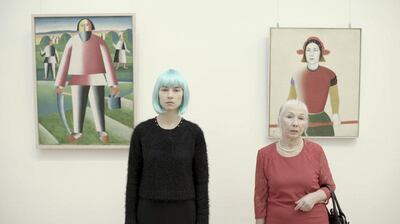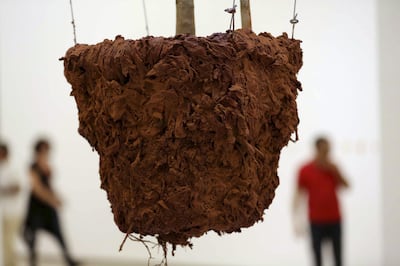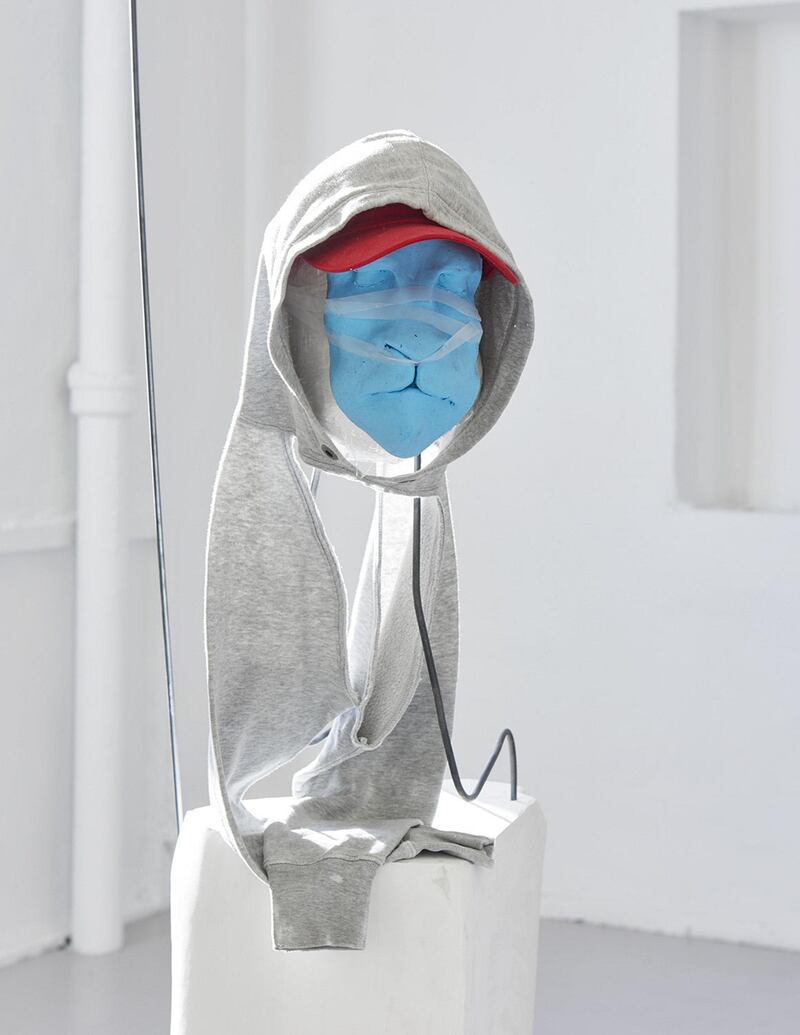Barely able to control the emotion in her voice, Christine Tohmé addressed the international audience that had gathered for Upon a Shifting Plate, the fourth and final off-site project of Sharjah Biennial 13: Tamawuj, which opened in Beirut on Saturday.
“As long as the geopolitical situation is tense, art and culture are suffering because people do not think they are priorities,” the curator explained, as she stood in the old warehouse that is now headquarters of The Lebanese Association for Plastic Arts, Ashkal Alwan, which she also directs. “This is a vulnerable time, but we need to go on working because this is the only place where multiplicity and plurality are at work in the Arab world.”
Tohmé’s sense of urgency and commitment to those values can be seen in the programme she has developed, not just for the off-site – two days of talks and culinary performances, lectures, screenings and exhibitions – but for the second and final act of this year’s Sharjah Biennial (SB13), which concludes not in the UAE but in Beirut.
Alongside a week-long roster of exhibitions, talks, film screenings, performances and book launches, the Biennial's main events consist of two exhibitions, both of which run until the new year. Exhibited at the Beirut Art Centre, Hicham Khalidi's An Unpredictable Expression of Human Potential includes works that take a profoundly local look at an international phenomenon: the experience of young people and their daily encounters with the state, violence, racism and exclusion. Reflecting on locations as disparate as Athens and Algiers, Casablanca and Paris, Basildon and Beirut, the show includes films such as Eric Baudelaire's Also Known As Jihadi (2017), which follows a young man's journey from the French suburbs to Syria and back again, and eventually to incarceration.

Based on real events and the evidence provided in judicial documents, the film examines the landscapes, both urban and rural, that the man experiences on his journey. It also asks how these reflect the social and political forces that led to his alienation, radicalisation and return. Downtown, the Sursock Museum is hosting the Reem Fadda-curated Fruit of Sleep, which features major existing works alongside new commissions. It picks up on the theme of dormancy that was explored by Zeynep Öz in BAHAR, the SB13 off-site that took place in Istanbul in June.
Started last year, Forensic Architecture's Ground Truth is an ongoing project that uses as combination of aerial photography and digital mapping technologies to provide historical, legal and material evidence of a Bedouin presence in a series of villages that sit on the edge of Palestine's Naqab Desert. One of these has been demolished more than 116 times in 60 years by the Israeli government.
One of seven works commissioned specially for SB13, Haitham Ennasr's A New City: On Disciplines of Love and Capitalism uses virtual reality to take visitors on a journey through Beirut's multilayered history. It asks how archaeologists and historians of the future are likely to interpret the wreckage left from the city's current wave of development.
As SB13 Act II shows, Christine Tohmé’s approach has been to test the biennial format and to push it to its limits, reaching out to different locations across the wider region with off-sites in Dakar, Istanbul, Ramallah and Beirut, addressing local audiences and international issues.
If Tohmé’s aim was to support and nurture regional artistic talent, it has also projected SAF’s presence and patronage, promoting both the Biennial and the organisation as an innovative enabler whose presence can now be felt internationally and at the community level.

In the way that previous off-sites had been organised around themes of water, crops and earth, Upon a Shifting Plate focused on food and used talks, panel discussions and performances to explore the culinary sphere. As Tohmé explained in her written introduction, "the culinary is always plural, always social. It is a space for trying things out," which for the off-site meant talks such as Reflections on the Language of Food by the Egyptian poet Iman Mersal. This looked at rhetoric employed in popular Egyptian TV cooking programmes, while A Taste of Crime was an investigation of domestic violence in Egypt by Lebanese-Egyptian writer Sahar Mandour.
Candidly, the team from the ecologically focused design consultancy Spurse admitted that they were not trying to make food that tastes good, but to encourage their audiences to experience things differently. Their aim was to generate what they described as an intellectual and philosophical hunger among their audience. What this meant for the 60 confused participants who agreed to sit for Spurse's experimental dinner, Eating into Future-Past Cosmologies – Tasting the Future, was a 26-course tasting menu that was designed to take diners on a sensory journey through the Lebanese landscape.
The result was a “meal” that included inedible but purified river mud; seawater; beach pebbles and rocks; just-about-edible fish bones; wild plums; cactus fruit and pickled watercress – all of which were tasted in the name of environmental awareness and critical engagement with the many issues facing our landscapes.

Meanwhile, essentially privileged and largely western approaches to food, such as urban foraging and dumpster diving – the practice of eating the wasted food that restaurants and supermarkets throw away each day – came under attack in Deepa Bhasthi’s presentation, The Day After. For the co-founder of India’s Forager Collective, such practices were dismissed, short-sightedly, as being the affected habits of privileged hipsters.
If food is a form of practice and performance in its own right, a form of expression and communication and a realm where experimentation and alternatives are played out on a daily basis, then this was expressed most locally and lyrically by the Lebanese academic Tarek El-Ariss.
In The Ties That Bind, the associate professor of Middle Eastern Studies at Dartmouth College combined his own family history with that of Beirut and the fortunes of mfattqa, a traditional and once beloved dish made from tahini, sugar, rice and pine nuts. The delicacy is fast disappearing, largely because it takes hours of torturous preparation, soaking and stirring.
“If you really craved mfattqa, you had to work for it,” El-Ariss explained. “The dish was a kind of ritual in the house that everyone had to take part in.”
For El-Ariss, mfattqa not only offers insights into Beirut’s history, but also offers up different and more psychoanalytic and literary ways of thinking about community and freedom, which originate from deep within the Beiruti psyche and the unconsciousness of the city. “What does mfattqa mean? It literally means ‘the ripped one’. In Arabic, ‘to rip’ emerges from the root f-t-q,” said El-Ariss, explaining that in continental philosophy and literary theory, the notion of something that is ripped goes straight to the heart of notions of identity, both personal and collective. “So there is something in mfattqa that is literally about unmaking and about ripping and making. But in Beiruti Arabic, it also means to crave... [but] it is not any craving, it is a craving that comes at great price.”
Although mfattqa’s origins are obscure, it is believed that the dish was originally made to commemorate the story of the Old Testament prophet Job, or Ayyoub as he appears in the Islamic tradition.
______________
Read more:
[ Art Jameel launches major commissions programme for new, Dubai-based works ]
[ Lawrence Abu Hamdan wins 2018 Abraaj Group Art Prize ]
[ Shifting Ground, Ramallah: art under occupation ]
______________
Famous for the trials he went through in order to prove his faithfulness to God, Ayyoub is the embodiment of the suffering that is central to all monotheistic religions. “It’s about a bet between Satan and God, about the extent to which Job loves God and believes in him unconditionally,” the academic told his audience.
Mfattqa is traditionally served as part of Job’s Wednesday – Arba‘t Ayyoub, a celebration that is held in Beirut on the last Wednesday in April, because it is thought that Ayyoub swam and was healed of his leprosy off the coastline of Beirut. “So this means that Beirut is a city that is dedicated to the most sadomasochistic episode in the Old Testament,” explained El-Ariss. “But of course, I later discovered that almost every Mediterranean city has the same version.”
The question for the academic is whether Beirutis have given up on these binding rituals altogether, and whether they might not contain lessons for contemporary society, faced as it is with the return of political forces and regimes that are increasingly behaving as if the project of the Enlightenment had never existed.
“Have we replaced the tempting of Job by Satan with the regional powers that exist today? Have we replaced Jehova with some tyrant to the North or the South?” he asked. “Is there some leftover that continues to pull us down, but which also ties us together?”
For El-Ariss, food, and mfattqa in particular, offers an alternative metaphor for thinking about community. Not the industrial age, melting pot metaphor that once characterised North American multiculturalism. Instead, a distinctly Levantine version that allows for the continued existence of individual identities while bringing people together with rituals that bind them, but also offer alternatives. “Mfattqa is not based on a total unity of its ingredients, there is something that remains other, that remains separate, that is central to the dish itself. It doesn’t reduce products and identities; they are always ripped,” he explained.
For El-Ariss, that rupture offers the opportunity to move beyond Orientalist notions that the peoples of the region are trapped in an endless cycle of repetition, while offering an alternative to western notions of modernity, identity and the nation state. It might not have been art, but through food, the academic arrived at a way of thinking about community and citizenship that harmonises, while still allowing for plurality and difference.
El-Ariss’s position may not promise an end to the region’s trials, but it does propose a tantalising change in consciousness; one rooted in the potential for liberation found in shared histories and experiences – the ties that bind.





